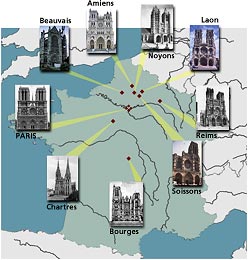| |
Saint-Pierre de Beauvais
Professor Stephen Murray
|
|
Begun some sixty-five years after the start of work at Notre-Dame in an important episcopal city fifty miles to the north of Paris, the choir of Beauvais Cathedral with its five-aisled pyramidal structure and great transept, its unusually broad central vessel and prodigious height, is amongst the most spectacular works of Gothic architecture.
 Click here for an Interactive Groundplan of Beauvais Cathedral in a new browser window.
Click here for an Interactive Groundplan of Beauvais Cathedral in a new browser window.
 |
 |
 |
 |
 |


France, Beauvais, Map of the medieval town |
|


France, Beauvais, Cathedral, Aerial view |
|


France, Beauvais, Cathedral, View of the choir, crossing
and north transept |
Its vertiginous vertical surge is more dramatic than Amiens Cathedral; its spatial program more ambitious. However, the monument has had a history plagued with conflict and structural failures. Begun in 1225 and occupied by the clergy in 1272, the choir was rebuilt during the half century that followed a collapse in 1284. Extended in the sixteenth century with the construction of the transept and beginnings of the nave, the cathedral, badly damaged in the collapse of the central crossing tower in 1573, was never completed and is still subject to chronic structural problems. Today Saint-Pierre of Beauvais, braced and trussed to avert further disasters, stands as a truncated giant, dominating a city itself devastated and extensively rebuilt after World War II. We must attempt to understand this great and enigmatic monument within the context of Gothic architecture and in light of its peculiar historical circumstances.
Beauvais Cathedral, contemporary structural supports added to brace the medieval building.
 |
 |
 |
 |
 |


France, Beauvais, Cathedral, Plan |
|


France, Beauvais, Cathedral, North transept |
|


France, Beauvais, Cathedral, Transept |
Gothic Architecture and Beauvais
The great Gothic cathedrals that encircle the Ile-de-France—Laon, Noyon, Soissons, Chârtres, Bourges, Reims, Amiens and Beauvais—share certain essential characteristics and differ sharply from the buildings of the immediate.
 |
|
| |
 |
None
of them are "copies" of Notre-Dame of Paris or any other building,
yet all share in the same process of structural and formal
invention. In "Gothic" architecture the reiteration of the
classical forms of "Romanesque" was transformed through a
deliberate search for novelty—a kind of medieval "modernism."1
The new architecture embodied light-weight rib
vaults and external supports in the form of flying
buttresses that allowed for the construction of lofty
cages of stone. Extraordinary control over the process of
stone cutting led to increasingly delicate effects of articulation.
Rationalization of production facilitated the construction
of enormous and complex edifices whose multiple elements were,
in a sense, mass-produced—stamped out in the pattern
of the templates designed by master masons who combined ingenuity
with vision.
While it was once customary to consider the Gothic cathedral
of Chârtres
(begun in 1195) as the "classic" progenitor of a family of
look-alike offspring, we now recognize the significant differences
of each edifice. This was a kind of common language (koine)
expressing a new awareness of time and place; a new kind of
cultural identity, and yet preserving at the same time the
peculiar character of local dialects—a kind of local
pride of place. The meaning of the common language thus varied
in different localities according to local circumstances.
Although Gothic projected an ecclesiastical agenda, it was
also capable of reflecting the agency of the various local
secular powers—king, count and commune. In its own way
each great edifice created an image of Heaven and an appropriate
theater for the liturgy—yet
each also responded to immediate political and material circumstances.
| |
 |
|
| 1. |
|
M. Trachtenberg, "Gothic/Italian 'Gothic: Toward a redefinition," Society of Architectural Historians, March 1991, vol. 50, no. 1, pp. 22–37.
|
back to briefing main
briefing
| image index | resources
home page | site
image index | site resources
media center for art history, archaeology
and historic preservation | columbia univeristy
|
|

